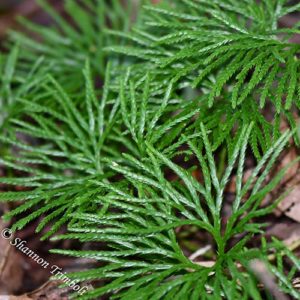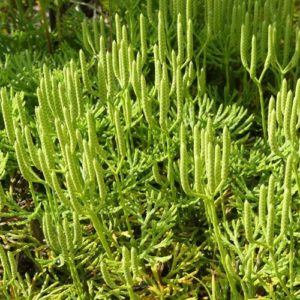Walking through my woods, I was excited to find a clump of ground cedar. My grandparents introduced this plant to me when I was kid, but they taught it to me by one of its other common names – running cedar, and I still sometimes call it that. To this day, I smile and think of them every time I find it.
General Biology and Life History
Ground cedar, running cedar, bears paw, crowsfoot, and fan clubmoss are all common names for members of the genus Diphasiastrum. There are three species of Diphasiastrum in the United States and southeastern Canada, but the most common and widespread is D. digitatum, also sometimes called southern ground cedar.

Despite their common names, ground cedars are not cedars, or even remotely related to cedars. Instead, they belong to a group of plants called clubmosses. (No, they aren’t mosses either. Common names can be so confusing sometimes.) Clubmosses are a very ancient group of plants and are among the plants often classified as “fern allies.”
Ground cedars in eastern North America are most often found growing in dry, shady woods. The vegetative parts look like little cedar trees poking up through the leaves of the forest floor. Like cedars, they are evergreen, so really standout in the winter when there isn’t much green vegetation on the forest floor.
Each of those “little cedar trees” is often connected to a single branch that grows along the ground, or just under the soil. Over time and in the right conditions, they can form a good-sized clonal patch. I’ve seen pictures of the entire forest floor carpeted in ground cedars, but I’ve never found a patch like that myself.
Like ferns, ground cedars reproduce from spores. The spores are produced in special structures that remind me of a candelabra or a hand with the fingers sticking up, but those structures are more often described as looking like a cluster of clubs. (That’s where the “club” part of the name clubmosses comes from.)
The reproductive structures stick up above the vegetation and are most often found in the summer and fall. When the spores are mature, they are released and spread by the wind. The germination and growth to maturity of ground cedars is complicated, and often involves symbiotic fungi and 15-20 years.
Pollinator and Wildlife Uses
Ground cedars aren’t flowering plants, and therefore don’t produce flowers so don’t attract pollinators or other flower visitors searching for nectar or pollen. I’ve also never seen any references to it being a host plant for any of our caterpillars. Most mammalian herbivores avoid eating ground cedars, because these plants contain chemicals that can be toxic if consumed in high amounts. I’ve found a few references to some species of ground nesting birds occasionally using ground cedars for nesting cover. I would also assume that small mammals, lizards, and other little critters might use ground cedars for cover, but that’s just speculation. In reality, we really don’t know a whole lot about how wildlife might use or interact with ground cedars.
Human Uses

Humans have used ground cedars and other clubmosses in a wide variety of ways. There is a long history of their used for medicinal purposes. The spores will also produce a bright light when lit in the air – a fact that apparently was used by Native Americans and later by early photographers. However, the most recent use, and the one which you may be most familiar with is as winter decorations.
Since ground cedar is evergreen and the vegetation forms on a long branch that is very flexible and can essentially serve as a rope, it was often used for holiday decorations. I distinctly remember my grandmother telling me how they used to gather it when she was a child to decorate with at Christmas time. I also remember being excited to find it in their woods many years later, and pulling it up to decorate their banisters. However, this is definitely one of those cases that falls under the spirit of Maya Angelou’s quote of “Do the best you can until you know better. Then when you know better, do better.”
Ground cedars can be extremely slow growing, especially when you take into account the length of time it takes for the plant to germinate and grow to the stage where you might even begin to think about collecting it. So, the biology of the plant coupled with the popularity of using it for wreaths and other holiday decorations, led to the overharvesting of ground cedars in many areas. Harvesting ground cedars for holiday decorations is no longer encouraged and populations in many areas are starting to recover. We now “know better,” and are striving to “do better.”
Incorporating Ground Cedar into Your Yard
As interesting as ground cedars are and as potentially appealing as they are for a shady, dry ground cover, they really don’t transplant well. They need specific fungi in the soil in order to grow and reproduce. Attempts to transplant them from where they are found growing naturally to other areas (like our yards) is rarely successful. Cultivating them from spores can also take decades, so you aren’t likely to find them commercially available either. Ground cedars are one of those plants that are best enjoyed and appreciated where you find them. If “where you find them” happens to be in your yard or on your property, then consider yourself extra lucky.
Summary
Ground cedar is a very interesting, evergreen plant that is related to ferns. They grow in shady, dry woods throughout much of the eastern U.S. and southeastern Canada. Humans have been using ground cedars for a variety of purposes for hundreds of years. However, despite how interesting they are, they are best allowed to grow in the places that they are naturally found. Their long, slow, complicated life history including their symbiotic relationship with fungi in the ground, keep them from being a good candidate for transplanting or cultivating in garden settings.

Do you want to make your yard more pollinator and wildlife friendly, but aren’t sure where to start?
Check out my book, Attract Pollinators and Wildlife to Your Yard: 15 Free and Easy Ways, for some easy, quick wins to get you started.

Backyard Ecology: Exploring Nature in Your Backyard
Nature isn’t just “out there.” It’s all around us, including right outside our doors. Hi, my name is Shannon Trimboli, and I am the host of Backyard Ecology. I live in southcentral Kentucky and am a wildlife biologist, educator, author, beekeeper, and owner of a nursery specializing in plants for pollinators and wildlife conservation. I invite you to join me as we ignite our curiosity and natural wonder, explore our yards and communities, and improve our local pollinator and wildlife habitat. Learn more or subscribe to my email list at www.backyardecology.net.

Leave a Reply